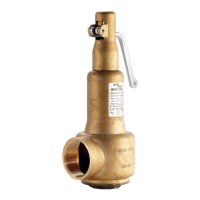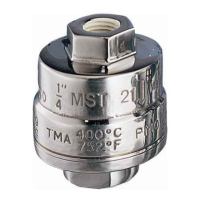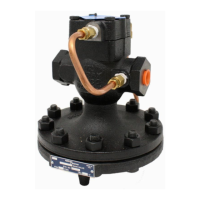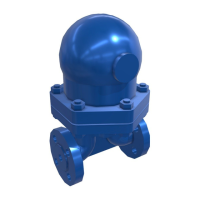IM-P316-03 CTLS Issue 14
12
Note: Before actioning any installation observe the 'Safety information', Section 1.
CAUTION !
Take care if using liquid jointing compounds (particularly thread sealants such as 'Loctite' or 'Stag') that
these don't contaminate internal seating faces.
In extreme cases, this type of contamination may cause these faces to stick together, causing a potentially
dangerous overpressure situation.
6.1
The valve should always be mounted vertically upwards with its main axis vertical.
6.2
The valve should be fitted to the pipework or vessel by means of the shortest possible length of
pipe or fitting.
6.3
There should be no intervening valve or fitting i.e. it should not be possible to isolate the safety
valve (Figure 4).
6.4
The inlet pipe connection should not be smaller than the valve (see Figures 7 and 8).
6.5
Built up backpressure occurs as a result of a safety valve relieving into the discharge pipework.
To ensure adequate system protection and correct safety valve performance, Spirax Sarco
recommend that this built up backpressure does not exceed 10% of the gauge set pressure. This
value may be exceeded even when using short runs of pipework of the same nominal bore as the
safety valve outlet.
It is the responsibility of the installer/owner to ensure that this requirement has been met by carefully
considering the nominal bore and length of the discharge pipe, as well as the type and quantity of
bends and pipe fittings to be installed.
Long radius bends and fittings are recommended.
Where there is any doubt as to the suitability of the discharge pipework system, please contact
Spirax Sarco for further guidance.
6.6
Direct the outlet pipework to a safe point of discharge where there is no risk of injury to persons or
damage to property in the event of the valve operating.
6.7
The outlet pipework should be adequately supported such that it does not place undue stress on
the safety valve.
6.8
Where the outlet pipework is directed upwards a small bore drain should be provided at the lowest
point (Figure 5). This drain should be taken to a place where any discharge will not create a hazard
or inconvenience.
6.9
Each safety valve should have its own unrestricted discharge pipe.
6.10
Safety valves should not be lagged.
6.11
Safety valves can operate very suddenly and will be too hot to touch without protection when
installed on steam systems.
6.12
Always use a wrench on the hexagon to secure the valve to the inlet pipe. Do not use pipe grips on
the body. Do not use excessive leverage or force.
6. Installation

